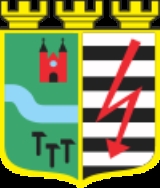
Zawiercie
Encyclopedia
Zawiercie z is a city
in the Silesian Voivodeship
of southern Poland
with 55,800 inhabitants (2005). It is situated in the Kraków-Częstochowa highland near the source of the Warta River
. The city has also historically been known by the names Zaveyurchy, Zavertse, Zavirtcha and Zavyerche.
of Silesia
but was not part of Silesia until the 20th century, when it was made a part of the Silesian Voivodeship
.
In the 12th century the settlement was a village called Kromołów (currently a district of Zawiercie). It expanded in the 19th century and received town privileges
in 1915. While Zawiercie was occupied by Nazi Germany
, it was known in German
as Warthenau between 1941 and 1945. During that time, many Jews were expelled to Zawiercie, where a ghetto was eventually established.
In 1847, the Warsaw-Vienna Railway
was completed. The railroad connection facilitated the trade between Russia, Germany and Austria. The fact that Zawiercie was located less than one kilometre from the railroad triggered the rapid development of the region. Twenty-five years later, there were coal and iron ore mines in Zawiercie and an industry was developed around the mines in the town. The first industrial plant, a glass factory, started around 1870. Immediately other industries followed; a large cotton spinnery, large weaving mill, iron mining, cast iron, brick manufacturing, sawmill, chemical laboratories, steam and water flour mills, machining, etc. The flourishing economics accelerated the local population growth.
City
A city is a relatively large and permanent settlement. Although there is no agreement on how a city is distinguished from a town within general English language meanings, many cities have a particular administrative, legal, or historical status based on local law.For example, in the U.S...
in the Silesian Voivodeship
Silesian Voivodeship
Silesian Voivodeship, or Silesia Province , is a voivodeship, or province, in southern Poland, centering on the historic region known as Upper Silesia...
of southern Poland
Poland
Poland , officially the Republic of Poland , is a country in Central Europe bordered by Germany to the west; the Czech Republic and Slovakia to the south; Ukraine, Belarus and Lithuania to the east; and the Baltic Sea and Kaliningrad Oblast, a Russian exclave, to the north...
with 55,800 inhabitants (2005). It is situated in the Kraków-Częstochowa highland near the source of the Warta River
Warta River
The Warta is a river in western-central Poland, a tributary of the Oder river. With a length of approximately it is the country's third longest river. The Warta has a basin area of 54,529 square kilometers...
. The city has also historically been known by the names Zaveyurchy, Zavertse, Zavirtcha and Zavyerche.
History
The town lies near the historical regionHistorical region
Historical regions are delimitations of geographic areas for studying and analysing social development of period-specific cultures without any reference to contemporary political, economic or social organisations....
of Silesia
Silesia
Silesia is a historical region of Central Europe located mostly in Poland, with smaller parts also in the Czech Republic, and Germany.Silesia is rich in mineral and natural resources, and includes several important industrial areas. Silesia's largest city and historical capital is Wrocław...
but was not part of Silesia until the 20th century, when it was made a part of the Silesian Voivodeship
Silesian Voivodeship
Silesian Voivodeship, or Silesia Province , is a voivodeship, or province, in southern Poland, centering on the historic region known as Upper Silesia...
.
In the 12th century the settlement was a village called Kromołów (currently a district of Zawiercie). It expanded in the 19th century and received town privileges
Town privileges
Town privileges or city rights were important features of European towns during most of the second millennium.Judicially, a town was distinguished from the surrounding land by means of a charter from the ruling monarch that defined its privileges and laws. Common privileges were related to trading...
in 1915. While Zawiercie was occupied by Nazi Germany
Nazi Germany
Nazi Germany , also known as the Third Reich , but officially called German Reich from 1933 to 1943 and Greater German Reich from 26 June 1943 onward, is the name commonly used to refer to the state of Germany from 1933 to 1945, when it was a totalitarian dictatorship ruled by...
, it was known in German
German language
German is a West Germanic language, related to and classified alongside English and Dutch. With an estimated 90 – 98 million native speakers, German is one of the world's major languages and is the most widely-spoken first language in the European Union....
as Warthenau between 1941 and 1945. During that time, many Jews were expelled to Zawiercie, where a ghetto was eventually established.
In 1847, the Warsaw-Vienna Railway
Warsaw-Vienna Railway
The Warsaw-Vienna Railway was a railway system which operated in Congress Poland, a part of the Russian Empire, from 1845 until 1912, when it was nationalized by the Russian government...
was completed. The railroad connection facilitated the trade between Russia, Germany and Austria. The fact that Zawiercie was located less than one kilometre from the railroad triggered the rapid development of the region. Twenty-five years later, there were coal and iron ore mines in Zawiercie and an industry was developed around the mines in the town. The first industrial plant, a glass factory, started around 1870. Immediately other industries followed; a large cotton spinnery, large weaving mill, iron mining, cast iron, brick manufacturing, sawmill, chemical laboratories, steam and water flour mills, machining, etc. The flourishing economics accelerated the local population growth.

